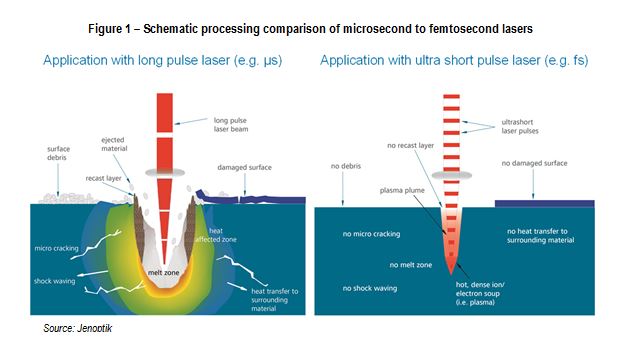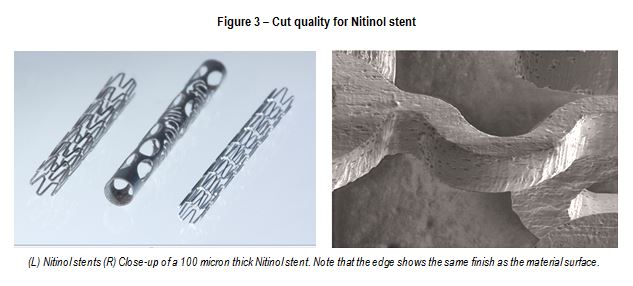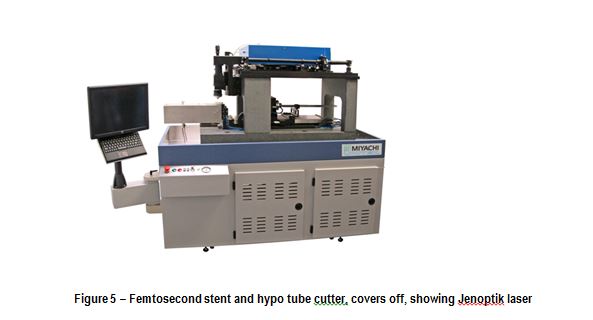Femtosecond Laser Processing Of Metal And Plastics In The Medical Device Industry
By Steven Hypsh, Jenoptik, and Geoff Shannon, Miyachi America
Finding the Holy Grail – Precision machining with no thermal affects and minimal post processing.
Microsecond (ms) fiber lasers have been successfully used for medical device applications like hypo tube and stent cutting for many years. While precise and fast, these lasers’ down side has been that the parts require a number of post processing operations after being cut, adding significantly to part cost and potentially damaging mechanically delicate parts.
In recent years, ultra-short femtosecond (fs) laser technology has been introduced which produces pulses that leave no thermal fingerprint on the part. These disk-based femtosecond lasers offer sub-400 fs pulses, plus best-in-class beam quality and peak power that enable an extremely high-quality cold ablation cutting process, rather than a melt ejection process. The resulting cut therefore requires minimal post processing, and the smaller beam size allows machining of very fine details.
The process works especially well for production of medical devices like catheters and stents, for medical and glass cutting and marking applications, and for 3D-structuring of ceramic material for dental implants. But perhaps the most interesting potential use is on a whole new class of bioabsorbable materials — polymers that safely remain in the body for controlled lengths of time before being absorbed — which are being developed as an alternative to traditional polymers or metal components.
In the past, fs lasers have been considered too slow for commercially viable operations. Recent studies evaluated cutting time per part and post processing steps, demonstrating that the return on investment (ROI) for a disk femtosecond laser can, in many cases be less, than 12 months, especially for high-value components. A key aspect of realizing the fs laser’s potential is the system platform, and to this end Jenoptik and Miyachi America are jointly developing both stage and scan head platforms that can fully unlock the promise of reaching this new level of quality and precision for micro treatment.
Femtosecond Basics
Femtosecond (fs) light pulses are ultra-short pulses (USPs). One fs equals 10-15 seconds and as a calibration point a 300 fs pulse equates to a physical length of pulse of only 90 micrometers (µm). Since there is no thermal processing as there would be in nanosecond (ns) pulses, USPs have many advantages, chief among them:
- No heat impact – No thermal tension in the material and no change of material characteristics
- No shock waves – No structural changes
- No micro cracks – Smooth processed surfaces
- No melting effects – No structural changes
- No surface damages – No rework or after-processing
- No debris – No cleaning necessary
- No ejected material – Clean surfaces
- No recast layer – Smooth edges
Figure 1 illustrates these effects on an application using a long pulse laser (for example, µs) compared to that of an ultra-short pulse laser, like an fs laser.

Femtosecond laser technology is not new; it’s been widely used in institutions and research centers for more than 30 years, but commercial-ready fs technology that can last in an industrial environment with a 24/7 qualification has been around for about the past 7 years. Originally used for wafer dicing and scribing of P1, P2, P3 solar panels or creating channels in panels for electrodes, fs lasers are now advancing into a new wave of machining capabilities, and many medical devices are excellent candidates, especially given the high cost of the components machined.
In addition to the ROI justification of minimized post processing, the fs disk laser can create unique features that were previously not possible due to quality concerns, particularly with polymers processing. Figure 2 shows the comparison of a nanosecond 355 nm source and a 1030 nm fs disk laser source processing polypropylene. The appearance of the disk fs hole shows little taper, no melting or heat effect distortion around the hole. This enables product design freedom to maximize functionality with little or no compromise to the manufacturing process.

Development Of Femtosecond Lasers For Medical Devices, Based On ROI Considerations
The edge quality possible with a femtosecond laser for both metals and plastics makes it excellent for machining heart, brain, and eye stents (both Nitinol and cobalt-chrome), as well as catheters, heart valves, and polymer tubing. The nearly cold cutting process means very fine feature sizes can be cut into the thinnest material, while still maintaining mechanical and material integrity. No internal water cooling is needed for even the smallest Nitinol diameter tube.
Quality improvements and the promise of reduced post-processing has always made fs laser technology a theoretical possibility, but until about six years ago there was little commercial interest in its use for medical devices, due to concerns about the expense and slow speed compared to other technologies.
That changed when some companies, including Jenoptik, developed an ROI tool to illustrate the true cost of post-processing. The tool can be used to factor in overall costs, including laser equipment purchase, post-processing capabilities, machine time, and handling time. The calculations demonstrate that femtosecond lasers are actually faster, because they alleviate several extremely time consuming post processing steps.
Take the example of the ubiquitous coronary stent, one of the first devices to be manufactured with a fiber laser. First, the part has to be machined, then honed, or cleaned out inside with a mechanical tool, and finally deburred. Then a chemical etch process must be performed to clean up around the edges, followed by an electro polishing step. Not only are these steps time consuming, they can also cause the part to become brittle, deformed and can have micro cracks.
Yields tend to be in the 70 percent range, meaning a significant amount of end product is lost. By contrast, the fs laser is a dry format – no water or heat is introduced in the part. The number of steps is drastically reduced; the part is machined and then undergoes an electro chemical process to round the edges. The integrity of the part is improved, several time-consuming steps are eliminated, and yields can be closer to 95 percent.
Figure 3 shows the high cutting quality of the fs laser for cutting of Nitinol stent material. The use of the fs laser prevents burr, and the slight roughness of the cutting edge gives a good precondition for the electro-polishing-process. Removal rate in this example was 0.25-5 mm/sec and material thickness up to 400 µm is possible.

The numbers definitely tell the story, as major medical device manufacturers are starting to understand the true ROI of more efficient machining technologies.
The femtosecond laser is also the only current technology appropriate for machining medical products out of new bioabsorbable polymers, which can be safely implanted in the body for controlled lengths of time before absorbing, without causing harm or adverse interactions. Next generation advanced bioabsorbables (also called aspirants) provide an alternative to traditional polymers or metal components and are being designed to meet precise degradation rates and other specifications.
The bioabsorbable material can be machined into any profile that can be used for stents. However, it must be machined correctly and without inducing heat. Failure to do so might lead to crystallization in the material, which would degrade its structure and affect its lifespan and ability to dispense medicine at the correct rate. Also, because bioabsorbables dissolve they cannot be cleaned like most plastics, nor can they be touched with any liquid solutions, another reason the fs laser is a better choice for the material.
Bioabsorbables are already being used for coronary stents in the European Union, although they have not yet received FDA approval for use in the U.S. Mostly composed of polyesters, primarily homopolymers and copolymers of poly (lactic acid) and poly (glycolic acid), bioabsorbables are showing promise for a variety of uses, including cardio stents for patients who may have been stented numerous times and can no longer tolerate a traditional fixed stent. The material is also being used to deliver medicines into organs of the body – for example, a plastic material like a sponge is doped with medicine and inserted into the liver, dispensing medicine at a consistent rate and lasting from six months to three years before dissolving. See Figure 4 for an example of an fs laser cut of a bioabsorbable stent.

After years of clinical trials, several firms are awaiting approval and already planning for the new innovation to hit the U.S. market, and several have been qualifying use of fs laser equipment to gear up for the precision micro-machining required.
Integrating The Femtosecond Laser Into A Micromachining Tool
The industrial robustness of the disk fs laser needs to be matched to an equivalent system to deliver the day in-day out reliability that the medical device industry demands. It is worth noting that the fs laser cannot currently be fiber-delivered and therefore is directed and delivered to the focusing optics by fixed mirrors. Thus, designing a beam delivery system for a 4-axis tube cutter that can make off axes cuts while maintaining alignment can be a challenge. The optical path design has to ensure that such key optical tools as the beam expander and fine tuning attenuator are easily accessible as needed for process development. The system design requires full mechanical isolation, and in some cases ambient temperature stability, to provide a system foundation for process repeatability.
To gain the system integration capabilities needed to move the femtosecond laser capability into the marketplace, Jenoptik teamed with Miyachi America. The first developed platform was based around Miyachi’s Sigma Tube cutter, as shown in Figure 5.
In a model unique in the industry, Miyachi is taking full ownership of the systems, providing the first line of support, including sampling processing, quoting, and building of the work cell, as well as installation, training, service, and warrantee. The work begins with understanding the end user’s process to determine a specific application’s system needs. This level of understanding can only come from the experience of running the application in house. While that knowledge is important with any process, it is magnified with ultrafast systems, which come with premium pricing. Miyachi uses its in-house femtosecond processing lab to provide a seamless transition from developing the application to the define-design-deliver approach used by the systems engineering group for both standard and custom system fulfillment.
Designing precision micro machining systems may appear to be just a question of determining how much granite is needed. While there is no doubt that mechanical stiffness and isolation are required, this is simply the starting point. Determining how delicate parts and materials will be repeatably positioned or clamped, implementing in-system part inspection, and incorporating real time optical beam diagnostics are several other key pieces of the puzzle.
For example, the beam is directed through the system by mirrors, so maintaining optical alignment is important, but this is only the first step. Ensuring that the beam profile and power levels are maintained requires the use of optical diagnostic tools – and these tools must be in line and non-intrusive, providing real time information. The tool is usually mounted directly after the laser and the last turning mirror in the beam path to enable deviations to be isolated to the laser or the optical beam path. Being in line and non-intrusive enables data collection during processing that can be time and date stamped as part of the manufacturing data.

Bright Future For Femtosecond Disk
The femtosecond disk offers unique in class process capability with excellent beam quality and high peak powers. To maximize the process capability for production the laser must be integrated into a system that enables high quality and repeatable processing. The combination of a highly robust femtosecond product that has been on the market for more than eight years with an experienced micro systems provider with in-house parts processing capabilities results in a partnership that can develop ideal production system solutions for high-value medical products.
